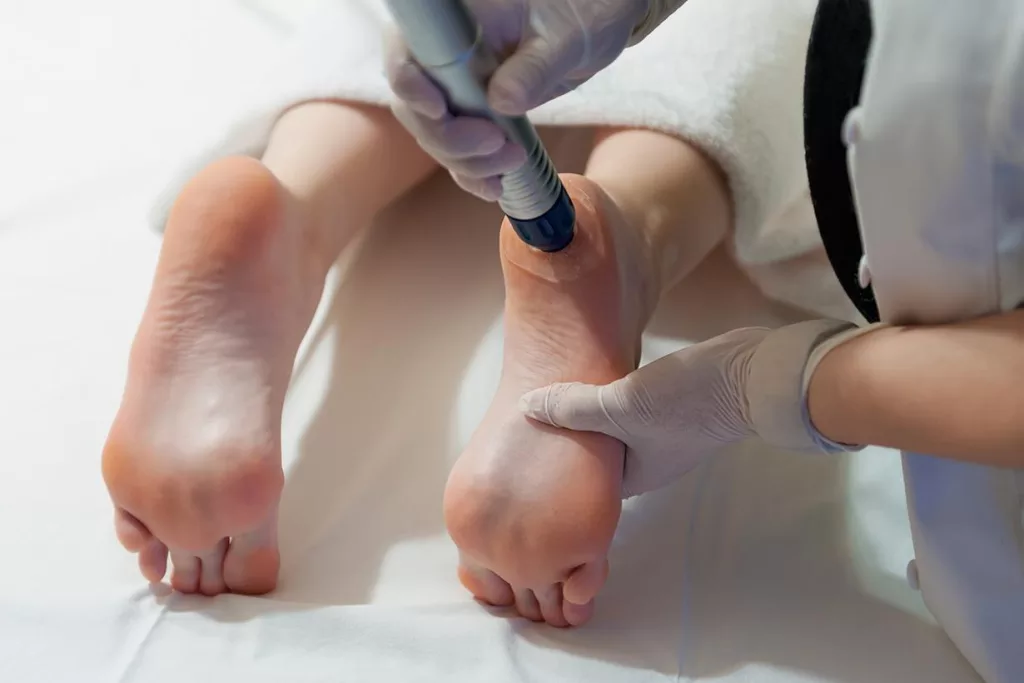Our Technology - Ankle Treatment
At Foot and Ankle Center of Arizona, we strive to make each visit as comfortable and painless as possible. We use cutting edge technology to treat you in the safest, most effective manner. Come visit our North Scottsdale office to find out more!
Toenail Fungus Removal Done by Doctors
Nail Fungus removal using our cutting edge FDA cleared Laser can change your appearance and give you the confidence to expose your feet and hands again. Our doctors have the required training and experience to diagnose and treat Nail Fungus using the FDA cleared Pinpointe Laser.
|
Digital Ultrasound
We utilize diagnostic ultrasound in our Scottsdale clinic to visualize soft tissue problems that cannot be seen on x-ray.
What is Diagnostic Ultrasound Imaging?
Ultrasound imaging is the use of sound waves to visualize the body. Just as expectant parents can see their child in the mother’s womb with the use of ultrasound imaging, we can visualize the structures of the foot and ankle.
Ultrasound is 100% safe – there is no radiation involved.
What can be diagnosed with ultrasound?
Ultrasound images can be useful in diagnosing the following conditions in the foot and ankle.
- Plantar fasciitis
- Plantar fascial tears
- Heel spurs
- Plantar fibroma
- Morton’s neuroma
- Achilles tendonitis or rupture
- Posterior tibial tendon problems
- Retrocalcaneal bursitis
- Ganglions
- Cystic masses
- Rheumatoid arthritis – capsular effusions and nodules
What procedures can the ultrasound be used for?
One of the biggest benefits of the ultrasound is to help guide us when giving performing injection therapy. We first put the skin to sleep with a topical anesthetic to limit the pain. Then we can use the ultrasound image to see exactly where we need to inject to help your particular problem.
How should I prepare for the procedure?
No preparation is necessary. Just wear comfortable, loose fitting clothing for your ultrasound exam.
How is the procedure performed?
First we position you on the examination chair. Then a clear gel is applied to the area that will be examined.. We then press the transducer against the skin and move it back and forth to image the area while reviewing the images on a monitor and capturing pictures.
What are the benefits versus the risks?
Benefits:
- Ultrasound scanning is noninvasive and painless
- Ultrasound is much less expensive than MRI, CT scan or bone scans
Unlike x-rays, ultrasound imaging uses no radiation - Ultrasound provides real-time imaging, making it a great tool for guiding injections or aspirations of fluid in joints or elsewhere.
- Unlike the magnetic field of MRI units, ultrasound is not affected by cardiac pacemakers or implants within the body.
Risks: For diagnostic ultrasound there are no known harmful effects on humans.
Digital X-Ray
The Foot & Ankle Center of Arizona utilizes a digital diagnostic imaging system that is specially tailored for the needs of a Podiatric Medical Practice. This system reduces the turnaround time of traditional x-ray processing and the images appear within seconds on monitors located within the patient treatment rooms.
These images are reviewed with patients in their exam rooms, reviewed prior to surgery, and stored in digital archives.
Plasma (PRP) Injections
What is PRP?
PRP is blood plasma with concentrated platelets. The concentrated platelets found in PRP contain huge reservoirs of bioactive proteins, including growth factors that are vital to initiate and accelerate tissue repair and regeneration. These bioactive proteins initiate connective tissue healing, bone regeneration and repair, promote development of new blood vessels and even stimulate the wound healing process.
How is the procedure performed?
To prepare PRP, a small amount of blood is taken from the patient. The blood is then placed into a centrifuge. The centrifuge spins and automatically separates the blood and isolating the PRP. The entire process takes about 15-20 minutes and increases the concentration of platelets and growth factors up to 500%.
What are the benefits of PRP treatment?
When PRP is injected into the damaged area it stimulates the tendon or ligament causing mild inflammation which begins the healing process. New collagen begins to develop and as it matures it begins to contract creating tightening and strengthening of the tendons or ligaments of the treated tissue. The patient’s own tissue is promoting this healing process as no foreign materials or medications are used other than local anesthetics to numb the treatment area.
How many injections will I need?
While response to therapy does vary, most people will require a series of 3-4 injections. Injections are normally scheduled at 4 week intervals. Recognizing that inflammation is a natural part of healing and a desired effect in PRP therapy, treatments may need to be modified to achieve the greatest results.
Does insurance pay for PRP?
At this time, PRP is generally not a covered service of health insurance companies.
Is PRP right for me?
If you have a tendon, ligament or muscle injury, chronic plantar fasciitis or a non healing achilles tendon condition which has failed to improve with conservative therapy then PRP may be the solution. Following appropriate evaluation and possible MRI imaging Dr. DiNucci will determine if PRP is appropriate for your condition. He will explain all aspects of care and determine if you fit the criteria for PRP therapy.
